Library
![]()
The title of this article is ambiguous. For other meanings, see Library (disambiguation).
A library or librarian is a service institution that provides access to information for its users. With regard to the variety of content collected by libraries, a library can be broadly defined as a collection of published information.
Libraries collect, develop, preserve and make information available. Mostly this is done by providing media, digital content and services. Libraries provide information about their collection through some form of printed catalogue or electronic database. In this, libraries differ from simple bookstores.
Access and use are mostly free of charge, in some cases borrowing is required for a fee. Most libraries are financed with tax money; but also church, public and private organizations as well as companies maintain libraries.
A central service of libraries is to make media available for use. In many cases, users can borrow them and take them out of the library for a set period of time. Reference libraries offer the use of media only within the library's own rooms without the possibility of borrowing. Some libraries also offer support in publishing their own texts or teaching materials (for example, as a university publisher or by providing infrastructure for e-learning), teaching information literacy (mostly at academic libraries) or promoting reading literacy (mostly at public libraries). The central work processes are the acquisition and segregation of media as well as the cataloguing of media, the activities in the library stacks and the lending desk.
In addition to printed media (such as books and journals), more and more libraries today also offer digital media (such as e-books, DVDs or electronic journals) and have digital libraries accessible on the Internet. Here, there are often restrictions with regard to the circle of users with access rights, which is due to licensing regulations of the publishers of electronic media.
Libraries are considered part of the cultural heritage and are one of the primary targets in many state and internal conflicts and are threatened by destruction, looting and robbery to finance the conflicts. Blue Shield International coordinates national and international military and civilian structures for the protection of libraries. Internationally, despite the partial dissolution of state structures and very unclear security situations as a result of the wars and unrest, robust undertakings are being carried out to protect libraries. This also includes the compilation of "no-strike lists" containing the coordinates of important cultural monuments such as libraries.
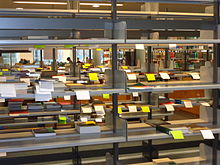
Service point of the Greifswald University Library (2016)
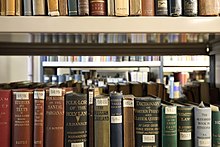
Book depository of the library of the Volkskundemuseum in Vienna
.jpg)
Current user card of the Bayerische Staatsbibliothek
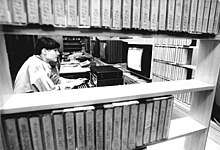
First software library of the GDR in the municipal and district library of Dresden (1989)
Library types
→ Main article: Library types
Libraries can be classified according to various criteria. The most common division is into public libraries (ÖB) for the general public and academic libraries (WB), which are also open to the public but are specifically geared to the needs of academics and students.
Other criteria for distinguishing libraries are, for example, the size of the library (e.g. one-person libraries) or the respective collection focus (e.g. music libraries). Other criteria are the type of library (e.g. corporate libraries, monastery libraries) and the function of the library (e.g. national libraries, cantonal libraries, municipal libraries).
Usage
Today, almost all libraries are freely accessible, exceptions can be private libraries of companies, but also special libraries of other institutions. Some university libraries also charge flat-rate user fees to users who are not members of the respective universities. Payment is not required until the first loan of a medium, whereby mostly flat, low annual fees are charged. Users almost always have to obtain a user card from the library before borrowing the item for the first time.
Magazine stocks
All or part of a library's media may be located in stacks, which may only be accessed by library staff. This is referred to as stacks. Such media must be ordered for viewing and borrowing. The channel predominantly used today for stacks orders are the libraries' online catalogues (OPACs), which are freely accessible via the Internet. In these catalogues all media are listed together with their location in the library and can be found and ordered by the user via search terms. In other cases, stacks are ordered using forms which are filled in on paper and handed in. Based on the order, library staff then remove the book from its location in the stacks and place it ready for pickup by the user. This process is referred to as retrieval.
Presence stocks
In addition to the holdings in the stacks, there is almost always an area accessible to users in which media can be used and browsed (open access holdings). Some of these open access holdings are used frequently (e.g. reference works or daily newspapers) and therefore cannot be borrowed, but are only intended for brief use on site (reference holdings). Particularly old and valuable media also belong to the non-borrowable stock. Media not available in the respective library can be suggested for purchase or ordered from other libraries via interlibrary loan.
Users generally have access to reading rooms, often also computer workstations with internet access or even their own cubicles. Furthermore, there are almost always photocopiers and book scanners, in public libraries also playback devices for music CDs and DVDs.
As a rule, media have a library-specific number (shelfmark), by means of which the location of the specimen can be easily found. The holdings accessible to users are usually arranged in a specific order.
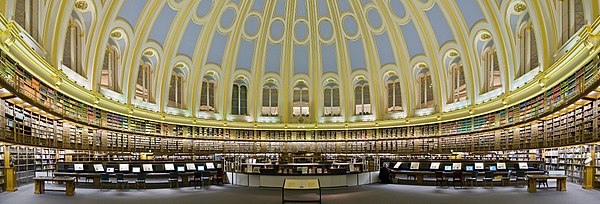
enlarge and show information about the picture
![]()
Reading room at the British Museum (2006)
Digital assets
Digital collections and repositories for electronic publications and research data are part of the digital holdings in libraries.
New forms of use
More recently, the forms of use of libraries have been changed or expanded. Non-text-based knowledge transfer is in the foreground, for example in Makerspaces. The various functions of libraries (e.g. "third place" for meetings) are the subject of discussion in the library sector. Gaming offers also belong to the new forms of use.
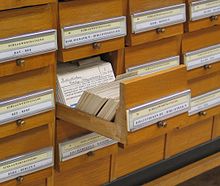
Card catalogue in the Graz University Library (2005)
Questions and Answers
Q: What is a library?
A: A library is a place where many books are kept. Most libraries are public and let people take the books to use in their home.
Q: Who works in libraries?
A: The people who work in libraries are librarians. Librarians are people who take care of the library.
Q: What do some libraries contain?
A: Some libraries keep famous or rare books, have a copy of every book which has been written in that country, and may also have other things such as magazines, music on CDs, or computers where people can use the Internet. In school they offer software to learn the alphabet and other details.
Q: Why are libraries important?
A: With the spread of literacy, libraries have become essential tools for learning. Libraries are very important for the progress and development of a society.
Q: What types of materials can be found in a library?
A: Libraries contain a variety of materials including printed materials, films, sound and video recordings, maps, photographs, computer software, online databases, and other media.
Q: Is a library the same as a bookstore?
A: No, a library is not the same as a bookstore (a store that sells books).
Search within the encyclopedia